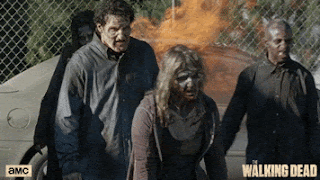First of all, of course, what kind of creatures are zombies in general, what do they eat and drink, let's see how the fictional world has described them.
Zombies are flesh-eating (usually brain-eating), rotting, and staggering corpses whose sole purpose is to feed, and do not speak but growl. Unlike other classmates, zombies entered the fictional world from a real point of departure. The Ancient Greeks, who fixed their dead with heavy objects like rocks to prevent them from respawning, may have been the first civilization to fear zombies. Of course, the origin of the zombie legend is not the Ancient Greeks, but West Africa.
After the French domination of West Africa, large numbers of people were enslaved to work in the sugarcane fields. Many slaves died due to the heavy workload. Due to the harsh working conditions, these slaves appeared to be dead. The only way for slaves to escape this circumstance was death, but the fear of becoming the soulless walking dead kept them from committing suicide. The words 'ndzumbi' meaning 'corpse' in Gabon's Mitsogo language and 'nzambi' meaning 'spirit of a dead person' in Congo were used for slaves.
French law required slaves to convert to Catholicism. However, Africans could not completely abandon their traditions and a new religion emerged in which different traditional elements were combined. Voodoo…
After the advent of voodoo, the belief began to spread that zombies emerged from the reanimation of corpses by voodoo magicians called bokor.
Bokors were used to prepare various mixtures including tetrodotoxin by using objects such as plants, shells, fish, animal parts, and bones. Tetrodotoxin, also called zombie dust, is a deadly neurotoxin found in pufferfish and some other seafood. Tetrodoxine mixtures can cause zombie-like symptoms such as difficulty walking, mental confusion, and respiratory problems when used under lethal doses, at high doses it causes paralysis and coma. This can result in someone being buried alive because they appear to be dead and then waking up.
The story of Clairvius Narcisse, who is definitely mentioned when real zombie cases are mentioned, is similar to the application of zombies for the purpose of enslavement. Narcisse reappears in 1980, 18 years after his death in 1962. His sister, Angelina, runs into him at a convenience store. When asked later, Narcisse recounts his memories of being buried alive. He was allegedly exhumed sometime after he had been rendered dead by a bokor and buried. He was then put to work as a slave in a field. After escaping two years of slavery, he began wandering around the Haitian countryside and was unable to return to town until he received news of the death of his brother, whom he believed to be the bokor he was talking about.
Later, when investigating Narcisse's condition, a researcher named Wade Davis found that the main cause was a herb called datura, which can cause hallucinations, delirium, confusion, psychosis, and memory loss.
After this inspiration from the past, of course, it would not be possible if the fictional world did not adopt the zombie element. Zombies began to appear in the movie world in 1932 with White Zombie (The Living Dead). Today’s terrifying portrayal of flesh-eating zombies emerged in George Romero's 1968 classic film, Night of the Living Dead. Afterward, zombies gained a huge fan base and dozens of zombie movies were made in both horror and comedy genres.
Let's come to real zombie examples in nature.
Zombie ants... One of the species of Ophiocordyceps fungus, which has many species known to be poisonous to animals, can take control of the insect's brain after infecting some insects and completely change its nature.
One of these species, "Ophiocordyceps unilateralis sensu lato", infects and controls carpenter ants (Camponotus castaneus), which is native to North America. Infected carpenter ants turn into zombies and have to work for the benefit of the parasitic fungus.
Zombie Spider… Zoologist Philippe Fernandez-Frournier from the University of British Columbia revealed that the Zatypota wasp can infect Anelosimus eximius spiders. A. eximius spiders, which live in groups and do not stray too far from their colonies, have been noticed to exhibit unusual behavior, such as leaving their colonies after being infected with Zatypota larvae and spinning tight cocoon-like webs in remote areas. Zatypota larvae have been found to develop inside these cocoon-like webs.
The eggs of Zatypota wasps settle in the abdomen of A. eximius spiders and when the larvae hatch, they begin to feed on the spider. The larva takes complete control of the host, allowing it to produce cocoon-like structures as a nest where the larvae will develop into adult wasps. Before entering the cocoons, the wasp larvae completely devour the host.
Researchers at the John Innes Center in the United Kingdom found in 2014 that a type of bacteria known as phytoplasma, which is spread by insects, infects plants like the 'goldenrod', causing it to produce leaf-like appendages instead of normal flowers. Although this change does not cause the death of the plant, phytoplasma attracts more insects thanks to these newly developing appendages, causing the bacteria to spread over a wider area and infect other plants.
Human Zombie Examples
When we look at the behavior of the species described as zombies in insect samples, you may have noticed that the common point is not that they reawaken after death, but rather that they are taken under control by another species. Zombie-like humans based on voodoo were likewise slaves whose wills were virtually disabled. A similar method is also found in Middle Asian myths. Mankurtizing…
Mankurt, which is mentioned in ancient Turkish, Kazakh, and Kyrgyz epics and Middle Asian myths, was a very common torture and mind control method among the peoples of Middle Asia.
In order to make a person mankurt, first, the person's hair was shaved off, the camel's neck skin was stretched on his head, and the person was left in this state for a few days under the sun in the hot desert. Due to the heat, the camel skin shrinks and sticks to the head, and begins to merge with the scalp. When the scraped hair starts to grow, it does not pierce the camel skin, it grows inwards, not outwards. It causes great pain because of the pressure of the camel skin and the hair that pierces the skull. When the person cannot bear these pains, after a while, he loses his memory and turns into a puppet. After that, the person who becomes Mankurt obeys whatever the owner orders.
Apart from these, let's look at a few cases of unexplained and later alleged zombies.
Cases such as a 30-year-old woman in Haiti, who was allegedly a zombie and died of the disease, 3 years later; A young man who died at the age of 18, 18 years later in a cockfight; an 18-year-old woman who died at 18 in an event 13 years later showing up was reviewed by Dr. Chacannes Douyon and Prof. Roland Littlewood and published in two articles in the Lancet.
When Dr. Douyon and Prof Littlewood examined these three zombies, they found that the first had catatonic schizophrenia, the second case had brain damage and epilepsy, and the third case had learning disabilities.
“People with chronic schizophrenia, brain damage, or learning disabilities are not uncommon in Haiti and are likely to be defined by the lack of willpower and memory characterized by zombies,” the researchers explain.
Another case report mentions a 53-year-old woman who came to the morgue with the complaint of being dead and smelling like rotting meat. In another similar case, it was reported that the 65-year-old man claimed that his organs had stopped working and that even the house he lived in was starting to fall apart. At some point, the man wanted to end his life and wrote in his suicide note that " he wanted to kill himself for fear of spreading a deadly infection to the townspeople that could cause them to get cancer." These cases pointed to Cotard syndrome, a psychiatric illness. This disease can cause people to act like zombies and have the illusion that they are dead or rotting.
Other than controllable slaves, people who make mysterious reappearances years later or believe they are dead as a result of pathological conditions, there are no similar wild creatures that exist to scare us in fiction. Isn't it? Unfortunately, blood-chilling zombie-like atrocities also exist in real life, although the reasons for some of them have not been fully determined.
In August 2016, a 19-year-old college student, Austin Harrouf, after leaving a restaurant where he went with his family in anger because of slow service then walked into the garage where Michelle Mischon and John Stevens III were dining. Harrouf stabbed the couple until they were killed for no reason. One of the neighbors called 911 and tried to intervene, but was stabbed by the attacker too.
When the police arrived, they found Harrouf naked, tearing off the couple's flesh and eating it. Harrouf was also growling, grunting, and making animal noises. Neither stun guns nor police dogs had been able to drive Harrouf away from the couple, and eventually, the police were able to remove him from the bodies by force.
The interesting thing is that before this strange murder, Harrouf was an exemplary student. It was reported that he was hanging out with some sort of fraternity group before joining his family for dinner, but the toxicology report came out clean. Tests for synthetic drugs were negative. Authorities reported that Harrouf did not show other characteristic symptoms specific to substances such as flakka or bath salts.
In Miami, Rudy Eugene attacked a homeless man Ronald Poppo and ate about eighty percent of the man's face. When the police arrived on the scene, the attacker opened fire to stop Eugene. Eugene had taken more bullets than his body could bear before he fell.
It was initially thought that Eugene might have used either bath salts or PCP, but the toxicology report revealed that he had only used a small amount of marijuana, and the reason for his zombie-like attack remained a mystery.
Drugs
Let's learn a little about the suspected drugs in such cases.
Let's start with perhaps the most famous zombie powder, bath salt, aka flakka. Contrary to its name, bath salt (Alpha-pvp) is not a cleaning agent, but a dangerous synthetic drug. This hallucinogenic substance strongly stimulates the central nervous system by inhibiting the reuptake of chemicals responsible for neurotransmission (norepinephrine-dopamine reuptake inhibition), such as dopamine and norepinephrine, which play a role in stimulating the body.
Methylenedioxypyrovalerone (MDPV), one of the ingredients in a bath salt, is a chemical in the same class as cathinone alkaloids, which are very similar to amphetamine, a stimulant substance. MDPV is structurally similar to methylenedioxymethamphetamine (MDMA) from the group of stimulant substances prohibited for medical use.
When bath salt is taken orally, it reaches the highest absorption within 1.5 hours and its effect lasts for 3-4 hours and is quickly discontinued. The total effect may last 8 hours or more. Snorting or injecting is very dangerous.
After use, effects such as euphoria, hypervigilance, hallucinations, talkativeness, and haste may be observed. Acute side effects include rapid heartbeat, chest pain, high blood pressure, increased body temperature, excessive sweating, dilated pupils, narrowing of the arteries, loss of appetite, muscle spasms, and seizures. At higher doses, severe panic attacks, psychosis, paranoia, confusion, insomnia, irritability, and violent behavior are observed.
Bath salts have proven to have high addiction potential, and higher doses may be required each time if resistance develops.
Experts say users of Flakka (bath salt) have developed a strong belief in their superhuman strength. Users have the power that comes with adrenaline and can resist four or five police officers. In one case, a woman named Stephanie describes her first flakka experience as “I just remember being underwater and feeling like I could breathe underwater.” She couldn't remember how she got out of the water or how she got to the hospital. In another, a 17-year-old girl jumps out the window of a stranger's house. She was covered in her own blood and was constantly shouting “I am God” and “I am the devil”. Individuals under the influence of drugs can die if they are not brought under control and receive immediate medical attention.
Phencyclidine (PCP), also known as angel dust, is a hallucinogen that disrupts human perception. It was an intravenous anesthetic in the 1950s but was discontinued due to its dangerous neurotoxic effects. People who use PCP experience numbness in their limbs, slurred speech, coordination disorders, and a sense of power and invincibility. Blank staring, rapid and involuntary eye movements and exaggerated gait were other observable effects of the drug. In addition to these, it can be observed in hallucinations, paranoia, visual impairment, mental disorders, the tendency to violence, psychosis, and forgetfulness. At higher doses, suicides can occur.
Cases of PCP use highlight the danger of the substance. Chevonne Thomas decapitated her 2-year-old son and put him in the freezer in 2012. She stabbed herself in the neck and died after calling 911 and confessing. It is known that Thomas lost custody of her child because she had previously used PCP. Angelo Mendoza ate his 4-year-old son's left eye while under the influence of PCP in 2009. After using PCP, a 29-year-old man perceived his arm as a danger as a result of an auditory hallucination, biting it almost to the bone as punishment, and felt no discomfort while doing this.
Desomorphine, also known as krokodil, is a codeine derivative. In addition to its sedative and analgesic effects, it has highly addictive properties. Those who use this substance by injection into a vein may develop serious skin ulcers, infections, and gangrene. The skin, which turns gray-green, is reminiscent of a crocodile, so it is named krokodil.
Medical case reports have described skin problems at the injection site that bruised to the bone. Ulcers and skin infections can cause jawbone destruction when they reach the person's gums. Many people with an infection in the mouth area may need surgery that involves cutting out tissue and parts of the jawbone. In short, the crocodile causes an infection that rots people while they’re alive.
As you can see, many methods can render a person almost unconscious despite appearing alive and moving normally. In addition, there are chemicals that can cause a person to become aggressive and even eat raw human flesh. Isn't it just how realistic it is that makes zombie scenarios even scarier? I know it's not a pretty scenario, but if a virus strain is produced with genetic material that can mimic the effects of several of the drugs I mentioned, a zombie invasion is inevitable. In this case, the only thing the virus will need is a living organism on which it will live. Afterward, we have already seen during the covid-19 period, how a virus can spread.
I wish you virus-free, disease-free and safe days.
Resources
https://medium.com/lessons-from-history/the-history-of-zombies-8f3aea14fed2
https://www.history.com/topics/folklore/history-of-zombies#section_1
https://www.ranker.com/list/real-zombies/christopher-shultz
https://www.medicalnewstoday.com/articles/326871
https://www.ranker.com/list/real-zombies/christopher-shultz
https://www.drugs.com/illicit/bath-salts.html
https://drugabuse.com/blog/shocking-stories-reveal-serious-dangers-of-flakka/
https://www.nbcnews.com/news/us-news/devils-drug-flakka-driving-florida-insane-n471531
https://allthatsinteresting.com/flakka-drug
https://www.drugs.com/illicit/pcp.html
https://hiphopwired.com/299124/bad-trip-7-pcp-related-crimes-photos/
https://jamanetwork.com/journals/jama/article-abstract/366204
https://www.drugs.com/illicit/krokodil.html
https://www.abc.net.au/news/2019-06-20/krokodil-the-russian-flesh-eating-street-drug-is-in-australia/11226686
https://bubisanat.com/posts/mankurtlastirma-ve-kozkamanlik-kavramlari-hakkinda-bir-inceleme

















Comments
Post a Comment